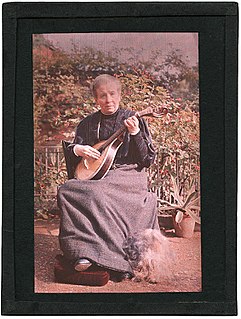
Photography is the art, application, and practice of creating durable images by recording light, either electronically by means of an image sensor, or chemically by means of a light-sensitive material such as photographic film. It is employed in many fields of science, manufacturing, and business, as well as its more direct uses for art, film and video production, recreational purposes, hobby, and mass communication.
The following list comprises significant milestones in the development of photography technology.

The cyanotype is a slow-reacting, economical photographic printing formulation sensitive to a limited near ultraviolet and blue light spectrum, the range 300nm to 400nm known as UVA radiation. It produces a cyan-blue print used for art as monochrome imagery applicable on a range of supports, and for reprography in the form of blueprints. For any purpose, the process usually uses two chemicals: ferric ammonium citrate or ferric ammonium oxalate, and potassium ferricyanide, and only water to develop and fix. Announced in 1842, it is still in use.

Sergey Mikhaylovich Prokudin-Gorsky was a chemist and photographer of the Russian Empire. He is best known for his pioneering work in colour photography and his effort to document early 20th-century Russia.
Color photography is photography that uses media capable of capturing and reproducing colors. By contrast, black-and-white or gray-monochrome photography records only a single channel of luminance (brightness) and uses media capable only of showing shades of gray.

The history of photography began in remote antiquity with the discovery of two critical principles: camera obscura image projection and the observation that some substances are visibly altered by exposure to light. There are no artifacts or descriptions that indicate any attempt to capture images with light sensitive materials prior to the 18th century.

Hand-colouring refers to any method of manually adding colour to a monochrome photograph, generally either to heighten the realism of the image or for artistic purposes. Hand-colouring is also known as hand painting or overpainting.

Park Town is a small residential area in central North Oxford, a suburb of Oxford, England. It was one of the earliest planned suburban developments in the area and most of the houses are Grade II listed.

Broad Street is a wide street in central Oxford, England, just north of the former city wall. The street is known for its bookshops, including the original Blackwell's bookshop at number 50, located here due to the University of Oxford. Among residents, the street is traditionally known as The Broad.
A chromogenic print, also known as a C-print or C-type print, a silver halide print, or a dye coupler print, is a photographic print made from a color negative, transparency or digital image, and developed using a chromogenic process. They are composed of three layers of gelatin, each containing an emulsion of silver halide, which is used as a light-sensitive material, and a different dye coupler of subtractive color which together, when developed, form a full-color image.
The Joly colour process is an early additive colour photography process devised by Dublin physicist John Joly in 1894.
Dye transfer is a continuous-tone color photographic printing process. It was used to print Technicolor films, as well as to produce paper colour prints used in advertising, or large transparencies for display.

Sir Henry Wentworth Dyke Acland, 1st Baronet, was an English physician and educator.
Sarah Acland, Lady Acland was the wife of Sir Henry Acland, Regius Professor of Medicine at the University of Oxford. She was a socialite and philanthropist. After her death, the Sarah Acland Home was established in her memory.

The Mount is the former official residence of the senior officer of the Royal Navy stationed in Gibraltar.

Sarah Angelina ("Angie") Acland was an English amateur photographer, known for her portraiture and as a pioneer of colour photography. She was credited by her contemporaries with inaugurating colour photography "as a process for the travelling amateur", by virtue of the photographs she took during two visits to Gibraltar in 1903 and 1904.

Belmond Reid's Palace is a historic hotel located to the west of Funchal Bay in Madeira, Portugal, in an imposing position looking out over the Atlantic Ocean. The hotel has beautiful sloping gardens. The hotel's complex include more than 40,000 square meters of space designed as a subtropical botanical garden.

This is a timeline of women in photography tracing the major contributions women have made to both the development of photography and the outstanding photographs they have created over the 19th, 20th and 21st centuries.
Jeannette Klute was an American photographer who helped develop the Dye-transfer process at the Eastman Kodak Company and is credited with demonstrating the artistic possibilities of color photography. Klute also paved the way for women to work in the photography industry.
Hallam Ashley, FRPS (1900-1987) was a British professional photographer who, amongst other things, photographed buildings for the National Buildings Record for nearly 40 years. A book of his photographs of East Anglia was published in 2010.












